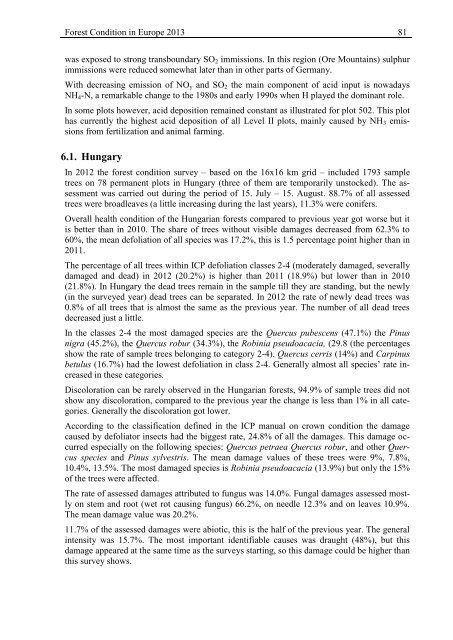Forest Condition in Europe - ICP Forests
Forest Condition in Europe - ICP Forests
Forest Condition in Europe - ICP Forests
You also want an ePaper? Increase the reach of your titles
YUMPU automatically turns print PDFs into web optimized ePapers that Google loves.
<strong>Forest</strong> <strong>Condition</strong> <strong>in</strong> <strong>Europe</strong> 2013 81<br />
was exposed to strong transboundary SO 2 immissions. In this region (Ore Mounta<strong>in</strong>s) sulphur<br />
immissions were reduced somewhat later than <strong>in</strong> other parts of Germany.<br />
With decreas<strong>in</strong>g emission of NO y and SO 2 the ma<strong>in</strong> component of acid <strong>in</strong>put is nowadays<br />
NH 4 -N, a remarkable change to the 1980s and early 1990s when H played the dom<strong>in</strong>ant role.<br />
In some plots however, acid deposition rema<strong>in</strong>ed constant as illustrated for plot 502. This plot<br />
has currently the highest acid deposition of all Level II plots, ma<strong>in</strong>ly caused by NH 3 emissions<br />
from fertilization and animal farm<strong>in</strong>g.<br />
6.1. Hungary<br />
In 2012 the forest condition survey – based on the 16x16 km grid – <strong>in</strong>cluded 1793 sample<br />
trees on 78 permanent plots <strong>in</strong> Hungary (three of them are temporarily unstocked). The assessment<br />
was carried out dur<strong>in</strong>g the period of 15. July – 15. August. 88.7% of all assessed<br />
trees were broadleaves (a little <strong>in</strong>creas<strong>in</strong>g dur<strong>in</strong>g the last years), 11.3% were conifers.<br />
Overall health condition of the Hungarian forests compared to previous year got worse but it<br />
is better than <strong>in</strong> 2010. The share of trees without visible damages decreased from 62.3% to<br />
60%, the mean defoliation of all species was 17.2%, this is 1.5 percentage po<strong>in</strong>t higher than <strong>in</strong><br />
2011.<br />
The percentage of all trees with<strong>in</strong> <strong>ICP</strong> defoliation classes 2-4 (moderately damaged, severally<br />
damaged and dead) <strong>in</strong> 2012 (20.2%) is higher than 2011 (18.9%) but lower than <strong>in</strong> 2010<br />
(21.8%). In Hungary the dead trees rema<strong>in</strong> <strong>in</strong> the sample till they are stand<strong>in</strong>g, but the newly<br />
(<strong>in</strong> the surveyed year) dead trees can be separated. In 2012 the rate of newly dead trees was<br />
0.8% of all trees that is almost the same as the previous year. The number of all dead trees<br />
decreased just a little.<br />
In the classes 2-4 the most damaged species are the Quercus pubescens (47.1%) the P<strong>in</strong>us<br />
nigra (45.2%), the Quercus robur (34.3%), the Rob<strong>in</strong>ia pseudoacacia, (29.8 (the percentages<br />
show the rate of sample trees belong<strong>in</strong>g to category 2-4). Quercus cerris (14%) and Carp<strong>in</strong>us<br />
betulus (16.7%) had the lowest defoliation <strong>in</strong> class 2-4. Generally almost all species’ rate <strong>in</strong>creased<br />
<strong>in</strong> these categories.<br />
Discoloration can be rarely observed <strong>in</strong> the Hungarian forests, 94.9% of sample trees did not<br />
show any discoloration, compared to the previous year the change is less than 1% <strong>in</strong> all categories.<br />
Generally the discoloration got lower.<br />
Accord<strong>in</strong>g to the classification def<strong>in</strong>ed <strong>in</strong> the <strong>ICP</strong> manual on crown condition the damage<br />
caused by defoliator <strong>in</strong>sects had the biggest rate, 24.8% of all the damages. This damage occurred<br />
especially on the follow<strong>in</strong>g species: Quercus petraea Quercus robur, and other Quercus<br />
species and P<strong>in</strong>us sylvestris. The mean damage values of these trees were 9%, 7.8%,<br />
10.4%, 13.5%. The most damaged species is Rob<strong>in</strong>ia pseudoacacia (13.9%) but only the 15%<br />
of the trees were affected.<br />
The rate of assessed damages attributed to fungus was 14.0%. Fungal damages assessed mostly<br />
on stem and root (wet rot caus<strong>in</strong>g fungus) 66.2%, on needle 12.3% and on leaves 10.9%.<br />
The mean damage value was 20.2%.<br />
11.7% of the assessed damages were abiotic, this is the half of the previous year. The general<br />
<strong>in</strong>tensity was 15.7%. The most important identifiable causes was draught (48%), but this<br />
damage appeared at the same time as the surveys start<strong>in</strong>g, so this damage could be higher than<br />
this survey shows.
















